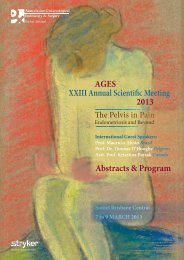to Obstetric Trauma Pelvic Floor Repair Surgical Essentials - AGES
to Obstetric Trauma Pelvic Floor Repair Surgical Essentials - AGES
to Obstetric Trauma Pelvic Floor Repair Surgical Essentials - AGES
Create successful ePaper yourself
Turn your PDF publications into a flip-book with our unique Google optimized e-Paper software.
Free<br />
Communications<br />
Session 7B<br />
Saturday<br />
4 June<br />
Session 7 - Free Communications B<br />
1350-1400<br />
MiniLap <strong>to</strong>tal laparoscopic<br />
hysterec<strong>to</strong>my: A video<br />
Lee S, Soo S, Ang C<br />
MiniLap Percutaneous Instruments are a family of ultra-thin,<br />
disposable graspers. The access insertion needle, which forms part<br />
of the instrument, eliminates the need for a trocar and port, leading<br />
<strong>to</strong> significant cost- and time- savings. Because these instruments<br />
measure only 2.3mm in diameter, closure of the insertion site is not<br />
required. The pos<strong>to</strong>perative cosmetic outcome is also improved.<br />
MiniLap Percutaneous Instruments further expands the range of<br />
surgical possibilities in the field of gynaecological endoscopy. In<br />
this presentation, the authors will summarise the rationale, case<br />
selection and port placement before the video of MiniLap <strong>to</strong>tal<br />
laparoscopic hysterec<strong>to</strong>my is shown. In the video, we will present<br />
the key elements, advantages and difficulties of this procedure.<br />
AUTHOR AFFILIATION: S. Lee, S. Soo, C. Ang; Royal Women’s<br />
Hospital, Parkville, Vic<strong>to</strong>ria, Australia.<br />
Session 7 - Free Communications B<br />
1400-1410<br />
SILS and pelvic floor repair, case<br />
presentation and video<br />
Behnia-Willison F, Jourabchi A, Hewett P<br />
Single Incision Laparoscopic Surgery (SILS) is a new method of<br />
laparoscopic surgery in gynaecology. This procedure enhances<br />
the benefits of traditional laparoscopic surgery such as decreased<br />
blood loss and minimal pos<strong>to</strong>perative pain. It also promotes a faster<br />
recovery process and has more cosmetic advantages.<br />
A <strong>to</strong>tal number of 45 SILS operations have been carried out in South<br />
Australia since 2009. For the first time in Australia, laparoscopic<br />
mesh sacrohysteropexy has been performed in with SILS method in<br />
Ashford Hospital.<br />
The video presentation shows mesh sacrohysteropexy with SILS<br />
method on a 70 year old patient with Global Prolapse Stage II. This<br />
surgery has been done through a single incision on the umbilicus. It<br />
lasted for about 55 minutes. It was uneventful and after 6 weeks the<br />
site of the surgery was scarless and the patient was satisfied with<br />
the results of the surgery.<br />
The aim of this study is <strong>to</strong> demonstrate the feasibility and safety of<br />
SILS in mesh sacrohysteropexy in vaginal prolapse.<br />
AUTHOR AFFILIATION: F. Behnia-Willison, A. Jourabchi, P. Hewett,<br />
Ashford Hospital/Flinders University, South Australia, Australia.<br />
Session 7 - Free Communications B<br />
1410-1420<br />
S-Portal vs SILS Single Incision<br />
Laparoscopic Hysterec<strong>to</strong>my – video<br />
comparisons<br />
Lee S, Soo S, Ang C<br />
Single incision laparoscopic hysterec<strong>to</strong>my has emerged as an<br />
attempt <strong>to</strong> further enhance cosmetic benefits and reduce morbidity<br />
of minimally invasive surgery. Single Incision Laparoscopic<br />
Hysterec<strong>to</strong>my (SILH) was first performed 20 years ago by Dr M.<br />
Pelosi, 2 years after the first <strong>to</strong>tal laparoscopic hysterec<strong>to</strong>my<br />
(TLH) was performed in 1989. In contrast <strong>to</strong> conventional TLHs,<br />
SILH required the insertion of laparoscopic instruments, as well as<br />
the laparoscope, all through a single umbilical incision. The first<br />
single incision laparoscopic hysterec<strong>to</strong>mies therefore encountered<br />
significant issues of peri<strong>to</strong>neal gas leakage, clashing instruments<br />
both intra- and extracorporeally and difficult closure of the<br />
vaginal vault due <strong>to</strong> lack of effective triangulation of instruments.<br />
These issues led <strong>to</strong> prolonged operative times and a paucity of<br />
laparoscopic hysterec<strong>to</strong>mies performed using the single incision<br />
approach in the early 2000’s.<br />
Recent advances in technology have brought SILH back in vogue.<br />
Multichannel access ports such as the SILS port by Covidien (Figure<br />
1) allows the insertion of three 5mm <strong>to</strong> 12mm cannulas through a<br />
3cm <strong>to</strong> 3.5cm incision in the umbilicus. This foam-based flexible<br />
port comes complete with a gas insufflation channel, ensuring<br />
minimal gas leakage. Laparoscopic dissec<strong>to</strong>rs that embody both<br />
functions of vessel coagulation and tissue cutting in one device,<br />
such as the Ligasure Advance, have improved the efficiency of<br />
SILH vastly. Laparoscopic Graspers that bend along the shaft, such<br />
as the Roticula<strong>to</strong>r made by Covidien (Figure 3), further improves<br />
the ergonomics of the SILH procedure by eliminating a significant<br />
limiting fac<strong>to</strong>r in single incision laparoscopic surgery – lack of<br />
instrument triangulation.<br />
Karl S<strong>to</strong>rz has recently decided <strong>to</strong> join the fray with their S-PORTAL<br />
family of devices designed for the purpose of single incision<br />
laparoscopic surgery. Karl S<strong>to</strong>rz introduced a family of reusable<br />
23

















